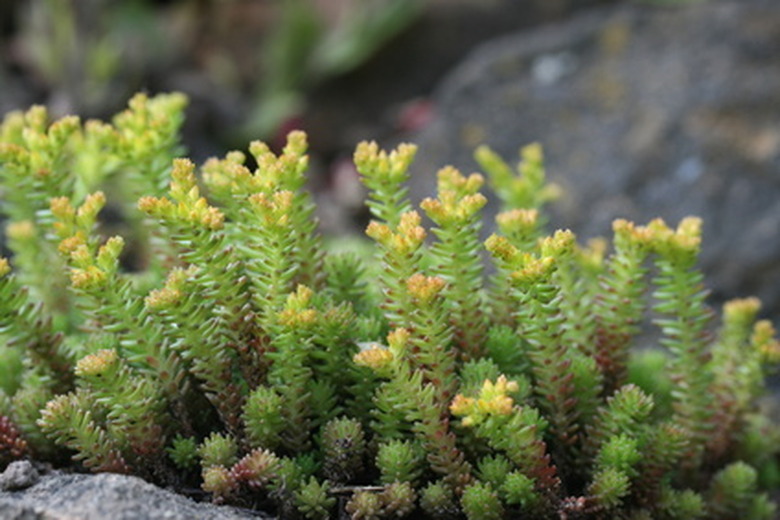Types Of Sedum
Gardeners prize sedums, also known as stonecrops, for their drought tolerance and shallow-rooted tendencies. These two characteristics make the low-growing sedum types ideal for roof or rock gardens. Both the tall and low sedums are useful plants for xeriscaping, which relies on water conservation. Consult your nursery for growing conditions specific to each of the many available types of sedum. As a general rule, these succulents prefer dry, rocky soil and grow well in sun or part shade.
Autumn Joy
The sedum spectabile cultivar Autumn Joy, one of the tall sedums, is much prized for its subtle colors and the charm it adds to fall gardens. When landscape options seem to be limited to chrysanthemums and pumpkins, Autumn Joy starts off with light pink blooms that deepen into a handsome red-brown by season's end. Even before it blooms in the fall, however, this sedum brings moderate height (it grows about 18 inches tall) and striking foliage to the garden. Many gardeners refrain from deadheading this sedum, leaving its seed heads for winter interest. Two related cultivars, "Meteor" and "Brilliant," bear similar flat-headed blossoms but stay a dusky pink all season.
- Gardeners prize sedums, also known as stonecrops, for their drought tolerance and shallow-rooted tendencies.
- Even before it blooms in the fall, however, this sedum brings moderate height (it grows about 18 inches tall) and striking foliage to the garden.
Vera Jameson
The University of Wyoming dubs the sedum hybrid Vera Jameson as the best of the tall sedums. Its fleshy leaves tend more toward the purple than the characteristic blue of many other sedums, which marry well with its "dusky pink flowers."
October Daphne
Another autumnal sedum, October Daphne (sedum sieboldii), boasts fleshy blue leaves and, during the fall, hot pink flowers at the edge of its branches. The plant grows about six inches tall.
Hens-and-Chickens
Perhaps the most famous member of the sedum family, the succulent Hens-and-Chickens earns its name by producing both tall and short rosettes of fleshy leaves in intricate, low-lying patterns. The translation of its botanical name, sempervivum tectorum–"Live forever on the roof"–attests to its usefulness in roof gardens. These sedums, sometimes called houseleeks, also make good houseplants or rock garden features.
- The University of Wyoming dubs the sedum hybrid Vera Jameson as the best of the tall sedums.
- Another autumnal sedum, October Daphne (sedum sieboldii), boasts fleshy blue leaves and, during the fall, hot pink flowers at the edge of its branches.
Gold Moss
Sedum acre, or gold moss, makes an ideal ground cover for small spaces, including between paving stones and among the rocks of a rock garden. The plants bloom with tiny yellow flowers. Garden writer Barbara Damrosch prizes its creeping habit, while the University of Wyoming warns it may reseed too prolifically for some gardeners' tastes.
Dragon’s Blood
This low-growing, mat-forming sedum thrives in rock gardens and other heat-retaining places. In fact, both the foliage and flowers of sedum spurium turn up the volume the more they bake in the sun. The plant blooms red in late summer, with the flowers intensifying into an orange-red in the fall. The plant spreads quickly.
- Sedum acre, or gold moss, makes an ideal ground cover for small spaces, including between paving stones and among the rocks of a rock garden.
Blue Spruce
The ground cover sedum rupestre Blue Spruce offers the characteristic blue leaves of the species. It bears yellow flowers.
Orange Stonecrop
Somewhere between a ground cover and a border plant, S. kamtschaticum bursts into orange-yellow flower in late summer. Its foliage tends toward the green rather than blue.
References
- Univseristy of Wyoming Cooperative Extension Service: Sedums
- North Carolina Cooperative Extension: Sedum
- Indiana Public Media: Hens-and-Chickens
- "The Garden Primer;" Barbara Damrosch; 1988
